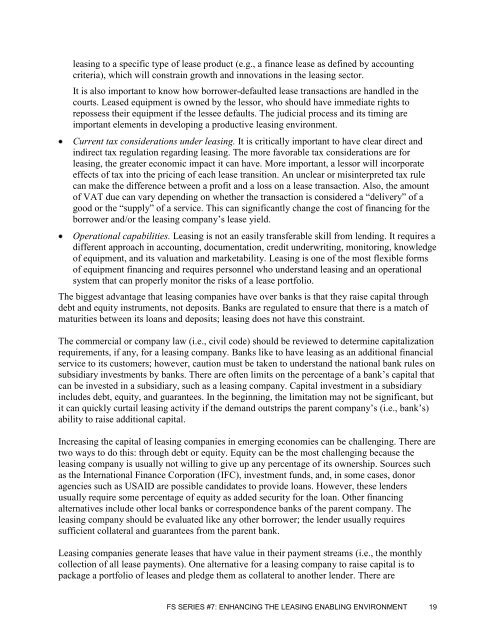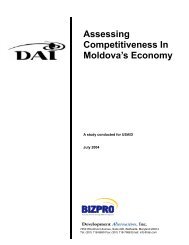Enhancing the Leasing Enabling Environment - Economic Growth ...
Enhancing the Leasing Enabling Environment - Economic Growth ...
Enhancing the Leasing Enabling Environment - Economic Growth ...
You also want an ePaper? Increase the reach of your titles
YUMPU automatically turns print PDFs into web optimized ePapers that Google loves.
leasing to a specific type of lease product (e.g., a finance lease as defined by accounting<br />
criteria), which will constrain growth and innovations in <strong>the</strong> leasing sector.<br />
It is also important to know how borrower-defaulted lease transactions are handled in <strong>the</strong><br />
courts. Leased equipment is owned by <strong>the</strong> lessor, who should have immediate rights to<br />
repossess <strong>the</strong>ir equipment if <strong>the</strong> lessee defaults. The judicial process and its timing are<br />
important elements in developing a productive leasing environment.<br />
Current tax considerations under leasing. It is critically important to have clear direct and<br />
indirect tax regulation regarding leasing. The more favorable tax considerations are for<br />
leasing, <strong>the</strong> greater economic impact it can have. More important, a lessor will incorporate<br />
effects of tax into <strong>the</strong> pricing of each lease transition. An unclear or misinterpreted tax rule<br />
can make <strong>the</strong> difference between a profit and a loss on a lease transaction. Also, <strong>the</strong> amount<br />
of VAT due can vary depending on whe<strong>the</strong>r <strong>the</strong> transaction is considered a ―delivery‖ of a<br />
good or <strong>the</strong> ―supply‖ of a service. This can significantly change <strong>the</strong> cost of financing for <strong>the</strong><br />
borrower and/or <strong>the</strong> leasing company’s lease yield.<br />
Operational capabilities. <strong>Leasing</strong> is not an easily transferable skill from lending. It requires a<br />
different approach in accounting, documentation, credit underwriting, monitoring, knowledge<br />
of equipment, and its valuation and marketability. <strong>Leasing</strong> is one of <strong>the</strong> most flexible forms<br />
of equipment financing and requires personnel who understand leasing and an operational<br />
system that can properly monitor <strong>the</strong> risks of a lease portfolio.<br />
The biggest advantage that leasing companies have over banks is that <strong>the</strong>y raise capital through<br />
debt and equity instruments, not deposits. Banks are regulated to ensure that <strong>the</strong>re is a match of<br />
maturities between its loans and deposits; leasing does not have this constraint.<br />
The commercial or company law (i.e., civil code) should be reviewed to determine capitalization<br />
requirements, if any, for a leasing company. Banks like to have leasing as an additional financial<br />
service to its customers; however, caution must be taken to understand <strong>the</strong> national bank rules on<br />
subsidiary investments by banks. There are often limits on <strong>the</strong> percentage of a bank’s capital that<br />
can be invested in a subsidiary, such as a leasing company. Capital investment in a subsidiary<br />
includes debt, equity, and guarantees. In <strong>the</strong> beginning, <strong>the</strong> limitation may not be significant, but<br />
it can quickly curtail leasing activity if <strong>the</strong> demand outstrips <strong>the</strong> parent company’s (i.e., bank’s)<br />
ability to raise additional capital.<br />
Increasing <strong>the</strong> capital of leasing companies in emerging economies can be challenging. There are<br />
two ways to do this: through debt or equity. Equity can be <strong>the</strong> most challenging because <strong>the</strong><br />
leasing company is usually not willing to give up any percentage of its ownership. Sources such<br />
as <strong>the</strong> International Finance Corporation (IFC), investment funds, and, in some cases, donor<br />
agencies such as USAID are possible candidates to provide loans. However, <strong>the</strong>se lenders<br />
usually require some percentage of equity as added security for <strong>the</strong> loan. O<strong>the</strong>r financing<br />
alternatives include o<strong>the</strong>r local banks or correspondence banks of <strong>the</strong> parent company. The<br />
leasing company should be evaluated like any o<strong>the</strong>r borrower; <strong>the</strong> lender usually requires<br />
sufficient collateral and guarantees from <strong>the</strong> parent bank.<br />
<strong>Leasing</strong> companies generate leases that have value in <strong>the</strong>ir payment streams (i.e., <strong>the</strong> monthly<br />
collection of all lease payments). One alternative for a leasing company to raise capital is to<br />
package a portfolio of leases and pledge <strong>the</strong>m as collateral to ano<strong>the</strong>r lender. There are<br />
FS SERIES #7: ENHANCING THE LEASING ENABLING ENVIRONMENT 19

















